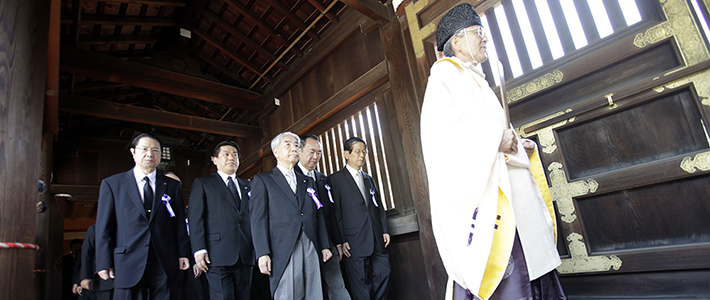
Japanese lawmakers visit the Yasukuni Shrine in Tokyo to offer prayers (AP Photo/Shizuo Kambayashi)
The Yasukuni controversy continues to rumble on.
At the same time as prime minister Abe was telling the world of Japan’s peaceful nature, he sent an offering to Yasukuni Shrine and sanctioned a visit by his wife. The public face for the rest of the world proved a mask hiding the nod to Nippon Kaigi and the extreme right within Japan.
Westerners unfamiliar with Japan naively maintain that prime ministerial ties to Yasukuni Shrine are simply a matter of honouring war dead. They assert Yasukuni is purely a religious issue. Nothing could be more ignorant, and nothing could be further from the truth.
The political role of Yasukuni was not only central to the discredited State Shinto, but continues to be central to the nationalist politics of revisionists who wish to reassert a militaristic Japan. This has been evident since 1978, the year in which Class A war criminals were enshrined. It marks the starting point of the current controversy.
When the Emperor himself refuses to visit Yasukuni, you can be sure there’s something pretty rotten at the heart of it all.
*************************
A Head Priest’s Ideological Agenda, Matsudaira Nagayoshi
(by Higurashi Yoshinobu for the nippon.com website)
The impasse [over enshrinement of 14 Class A war criminals] continued until Tsukuba’s sudden death in March 1978. Matsudaira Nagayoshi (1915–2005) was installed as head priest in July that year. It is worth going over Matsudaira Nagayoshi’s background…
Matsudaira’s father, Yoshitami (1882–1948), was the last minister of the Imperial Household. Matsudaira himself was a lieutenant commander in the Imperial Navy during World War II and an officer in the Self-Defense Forces after World War II. His father-in-law, Daigo Tadashige, was a vice admiral in the Imperial Navy. He was tried by the Dutch after the war, convicted of Class B and C war crimes, and executed by rifle shot. He is listed among the war dead honored at Yasukuni Shrine.
Matsudaira unequivocally rejected the verdict of the tribunal and argued that the Tokyo Trials had produced a distorted view of history that cast Japan as the sole villain. He was determined from the outset to enshrine Japan’s Class A war criminals at Yasukuni. This was part of an ideological crusade to discredit the Tokyo Trials.
Once appointed, he moved quickly. In a secret ceremony on October 17, 1978—just three months after becoming head priest—he enshrined all 14. When the story broke in April the following year, the public reaction was relatively muted. But controversy erupted with a vengeance six years later, when Prime Minister Nakasone Yasuhiro became the first postwar prime minister to pay homage at the shrine in an official capacity.
When Nakasone and his cabinet visited Yasukuni on August 15, 1985 to mark the fortieth anniversary of the end of World War II, the visit unleashed a storm of criticism from Japan’s Asian neighbors. The next year Nakasone agreed not to visit the shrine in deference to the views of Chinese leader Hu Yaobang.
From that time on, visits by cabinet officials to Yasukuni Shrine have been a hot-button issue, drawing intense criticism from abroad and stymying diplomatic progress between Japan and its neighbors. The ultimate source of this ongoing conflict was the enshrinement of Class A war criminals in 1978. And the enshrinement of this group cannot be attributed simply to religious or filial impulses. In fact, it was a blatantly ideological and political act driven by an urge to justify and legitimize a highly controversial chapter in Japanese history.

Exactly!
…”And the enshrinement of this group cannot be attributed simply to religious or filial impulses. In fact, it was a blatantly ideological and political act driven by an urge to justify and legitimize a highly controversial chapter in Japanese history”…